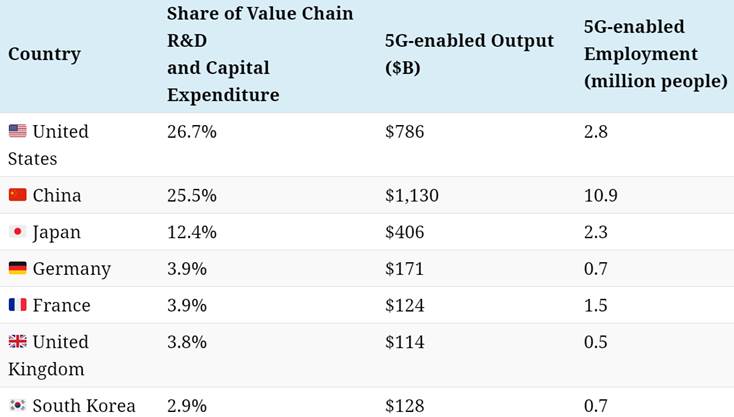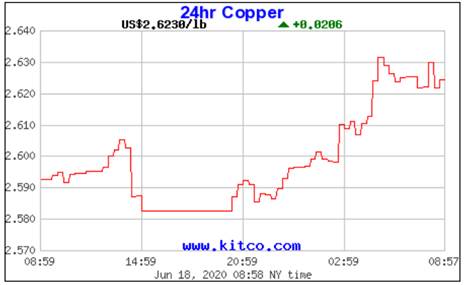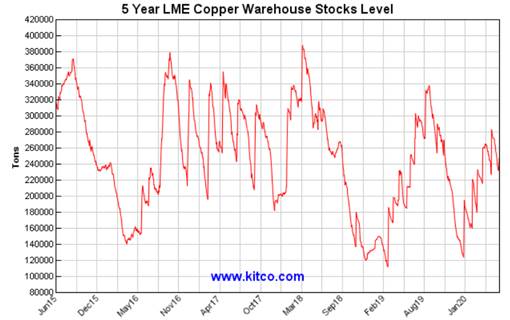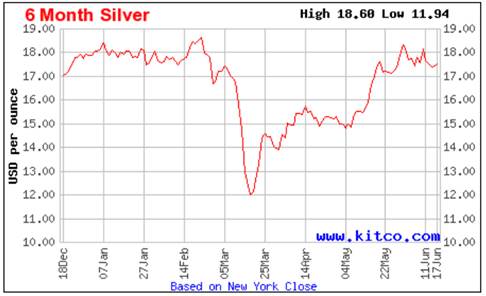Trillion-dollar US infrastructure plan will draw in plenty of metal
Commodities / Infrastructure Jun 24, 2020 - 03:53 PM GMTBy: Richard_Mills
Donald Trump appears to have torn a page from Ahead of the Herd’s manual for recharging the US economy.
In an earlier article we said what the global economy really needs, in this low-growth, spending-stalled environment brought about by the pandemic, is a push - something big that will attract huge amounts of investment, and workers. As we have suggested, this could be a massive infrastructure spending program, on the scale of President Roosevelt’s “New Deal”.
Not coincidentally - we like to think Trump reads AOTH - the administration is said to be preparing a nearly $1 trillion infrastructure proposal – some of the dollars are geared toward 5G/ Broadband - as a way of spurring the world’s largest economy back to life. US GDP growth fell 5% in the first quarter and when second-quarter economic output figures are released, they will be far worse, likely double-digit.
Fortune Magazine reported A preliminary version being prepared by the Department of Transportation would reserve most of the money for traditional infrastructure work, like roads and bridges, but would also set aside funds for 5G wireless infrastructure and rural broadband, the people said...
Trump is pushing to rev up the U.S. economy—which four months ago was the centerpiece of his argument for a second term—as he trails Democrat Joe Biden in most national polls. The White House has explored ways to shift the next round of federal virus aid from personal financial support to growth-fostering initiatives, such as infrastructure spending.
And hes not alone.
The European Commission has released a €1.85 trillion recovery plan focusing on “EU Green Deal” initiatives aimed at reaching the eurozone’s net emissions by 2050 target.
The Chinese have been touting their own form of blacktop politics as a way of restoring their economy, particularly manufacturing which has been hurt by the coronavirus.
Among the projects that could receive a huge boost in investment, courtesy of a $700 billion stimulus program, are a $44.2 billion expansion to Shanghai’s urban rail transit system, an intercity railway along the Yangtze River ($34.3B), and eight new metro lines worth $21.7 billion, to be constructed in the virus epicenter city of Wuhan.
Beijing recently kicked off a widely anticipated program focused on “new infrastructure” and “new urbanization”.
“Developing 5G networks and implementing them into the many industries of the global economy is a massive undertaking, and just seven countries are expected to account for 79% of all 5G-related investment.
By 2035, here’s how these countries are expected to rank.”

Visual Capitalist, Where 5G Will Change the World
According to BMO, new urbanization refers to refurbishing old urban housing stock, railways, airports, and upgrades to power grids and local utilities, while new infrastructure includes 5G networks, ultra-high voltage power grids, EV charging stations and data centers.
A global infrastructure spending push would mean a lot more energy metals will need to be mined, including lithium, nickel, cobalt and manganese for EV batteries; copper for electric vehicle wiring and renewable energy projects; and rare earths for permanent magnets that go into EV motors and wind turbines.
It’s an idea that has been kicked around quite a bit by Trump and his Cabinet, along with House Democrats.
In March, Trump talked about reviving a $2 trillion plan for improving the country’s roads, bridges, water systems and broadband Internet. Earlier in his presidency a $1.5 trillion plan for infrastructure spending became dead on arrival when Trump and the Democrats failed to agree on how to pay for it. Politics was also alleged to have played a role. Fortune reported Democrats said Trump walked out of a meeting on a $2 trillion plan and vowed not to work with them unless they stopped investigating him and his administration.
Nonetheless, infrastructure is back on the table, in a big way.
The Trump administration sees an existing infrastructure funding law, up for renewal by Sept. 30, as a vehicle to push the initiative through a broader package, sources told Fortune. The FAST Act authorizes $305 billion over five years. It could also be rolled into the next round of pandemic relief.
Meanwhile the Democrats, who have a majority in the House of Representatives, have reportedly offered their own proposal to renew infrastructure funding over five years. It includes investments in roads and bridges, measures that make facilities more resilient to climate change, and funding for public transit and Amtrak.
Fortune sums up,
Infrastructure spending has long held appeal for lawmakers as a way to spur growth, and the pandemic is renewing calls to fast-track roads and other projects.
What is 5G?
Upgrading cellular networks from 4G to 5G is expected to result in a vast improvement in Internet service, including nearly 100% network availability, 1,000 times the bandwidth and 10 gigabit-per-second (Gbps) speeds.
We hear a lot about 5G lately, especially the disagreement between the United States and Chinese technology company Huawei, which is seen by many as a trojan horse for the Chinese Communist Party, but before we go any further, what is 5G and what can it do?
5G is the next generation of mobile broadband that will eventually either replace or augment existing 4G LTE connections. The main benefits of 5G are its drastically improved upload and download speeds. Latency, which is the time it takes devices to communicate with wireless networks, is also much quicker using 5G.
Peak data rates under 5G are unbelievably fast. They can hit 20 giga bytes per second (Gbps) under downlink and 10Gbps uplink per mobile base station. These speeds however are not what a user would experience; they are the speeds shared by all users per 5G “cell”. Actual download and upload speeds for 5G are specified at a respective 100 megabytes per second (Mbps) and 50Mbps.
Unlike 4G, 5G operates on three spectrum bands: low, medium and high.
Low-band spectrum, also called sub-1Ghz, is what LTE wireless networks run on. While low-band spectrum offers great coverage, and is therefore the primary band used by US LTE carriers, it is also nearing the end of its bandwidth. Peak data speeds will top out at around 100 Mbps.
Mid-band spectrum is faster and has lower (ie. faster) latency than low-band, but it can’t penetrate buildings as well as low-band spectrum and peak speeds are only up to 1Gbps.
High-band spectrum, or mmWave, delivers the best 5G performance. It offers lightning-fast peak speeds of 10Gpbs and has extremely low latency. The problem is it has low coverage and poor building penetration, meaning to create an effective high-band 5G network will require many cells.
Currently AT&T and Verizon are rolling out high-band 5G spectrum. Until they can build out nationwide networks, these two carriers plan to piggyback off LTE. Once completed, 5G networks are expected to support 1 million devices per square kilometer, which is much higher than currently supported under LTE.
Experts say 5G is an absolute must if we want to continue using mobile broadband Internet. Carriers are running out of LTE capacity in major cities and users are already experiencing slowdowns during peak periods.
Among 5G’s uses are autonomous vehicles, which will be able to communicate with other vehicles on the road; public safety & infrastructure, such as widespread use of sensors that can track electricity usage, and can notify public works departments when lights burn out or drains flood; remote control use of machinery such as autonomous haul trucks; health care such as improvements in telemedicine and the facilitation of precision or even remote surgeries; and the Internet of Things (IoT), a broad term that describes systems of interrelated computing devices, mechanical and digital machines that have the ability to transfer data over networks without requiring human input.
While some neighborhoods already have 5G access, others are still waiting. AT&T, Verizon and T-Mobile began deploying it in 2019. All the major carriers in the US and Canada are working furiously to build out 5G networks; getting it all done will take years, although it’s expected that half of the US will have access to 5G by the end of 2020.
According to CNBC, the US Federal Communications Commission (FCC) rolled out the 5G Fast plan in 2016 to accelerate deployment of high-speed broadband in rural America, a program estimated to cost $9 billion The US government is paying around $10 billion to satellite providers to fast-track the auction of 5G C-band spectrum by 2023. C-band spectrum has the ability to download speeds greater than 1Gbps.
About 5% of the US population, more than 18 million Americans, lack access to high-speed Internet. Getting them connected is especially important now, considering many companies have loosened up on work-at-home policies due to covid-19; imo, the future of work involves a lot more working from home, where a fast Internet connection is essential.
Two controversies surrounding 5G are its potential health effects, and Huawei’s control over the technology.
Although Trump banned the use of Chinese components in the US 5G network, amid suspicions the devices would be used for espionage, his administration appears to be softening its position.
This week the US Commerce Department posted a new rule allowing American companies to work with China’s Huawei, to develop standards for 5G, an area in which Huawei is a leader.
Meanwhile Huawei Chief Financial Officer Meng Wanzhou continues to fight extradition from Canada on charges of bank fraud and accusations she misled HSBC about the company’s business in Iran. The daughter of Huawei founder Ren Zhengei was detained in Vancouver in December, 2018, at the request of the United States.
A bizarre rumor that 5G either helped fuel, or directly caused the coronavirus, has been debunked. The conspiracy theory that 5G radiation makes people vulnerable to covid-19 stems from long-enduring fears about mobile phone technology. As early as 1903 doctors talked about “radiophobia”, in the 1970s there were concerns about power lines and microwaves, and in the 1990s opponents of 2G technology suggested radiation from mobile phones could cause cancer.
There was also the theory that the coronavirus crisis was a ruse, deliberately created to keep people at home while 5G engineers installed it everywhere. Believers argued it was no coincidence 5G was trialed in Wuhan, the city in China where the virus originated, even though the technology was already being rolled out in a number of locations.
The reality is that low-band and mid-band 5G networks operate at around the same frequencies as existing networks. High-band 5G networks, which travel over millimeter wave frequencies, are even less of a health risk, because they can’t penetrate surfaces such as walls, trees or human skin.
An example of a millimeter wave frequency most people are familiar with, is airport scanners. You know the scan doesn’t penetrate the body because the image seen on the screen does not show organs or skeletal tissue.
Like FM radio waves and visible light, radio frequency waves are a form of "non-ionizing" radiation, which means they don't have enough energy to damage the DNA inside of cells and cause cancer, unlike X-rays, for example. Decades of research suggest that the only way wireless technologies could interact with the body is by heating the skin, but power levels are so low that's not a problem, experts say.
Critical minerals
Future broadband services that can handle large volumes of data transfer require a switch towards the use of new metal compounds in semiconductors, to achieve higher performance, compared to older silicon-based technologies.
According to Argus Media, which monitors metals and other resource markets,
The high frequency waves used in 5G networks have shorter ranges than the low-frequency signals in 4G networks, and the need for a higher proportion of base stations will result in the deployment of a large number of small cells rather than a small number of large masts. That will in turn require a larger volume of semiconductor materials.
Among the big winners could be gallium nitride (GaN), which operates at higher frequencies and power rates. UK-based consultant Roskill says 5G “is expected to be the next big catalyst for radio-frequency GaN,” and in a recent study forecast the total GaN market is expected to grow 30% from 2017 to 2023.
Another gallium compound likely to be in high demand for 5G is gallium arsenide (GaAs), used in smartphones, military radar and other communications applications.
According to the USGS, China contributed 95% of primary gallium production in 2018, in a tiny market of just 410 tons. The metal is on the US government’s list of 35 metals it says are critical to national security. Gallium is produced solely as a by-product of bauxite and zinc mining and processing. Although there are up to 1 million tons of gallium in the world’s bauxite resources and a considerable amount in the world’s zinc resources, the USGS expects only 10% of the gallium is recoverable.
5G is also expected to use up a lot of cobalt. According to BMO, the sale of 5G-capable cell phones will translate into more demand for cobalt, since mobile devices consume 35% of global cobalt supply. Most of the world’s cobalt is mined in the DRC – which has come under intense scrutiny for unsafe working conditions and the use of child labor.
Cesium, not to be confused with cerium, a rare earth element, is used in atomic clocks, making the rare metal essential for 5G networks. The “cesium standard” is how commercially available atomic clocks measure time, which is vital for data transmissions infrastructure of mobile networks, GPS and the Internet; without cesium, 5G doesn’t work - it means the difference between real-time responsiveness and 5G failure.
Currently there are only three pegmatite mines that produce it: Tanco in Manitoba, Bitika in Zimbabwe and Sinclair in Australia. The first two are no longer producing, and cesium stockpiles at Tanco and Sinclair are largely controlled by China.
Silver
Over 50% of silver demand comes from industrial uses like solar panels, electronics, and the automotive industry.
5G is set to become another major new driver of silver demand.
According to the Silver Institute, The electronic components that enable 5G technology will rely strongly on silver to make the global 5G platform perform seamlessly. In a future 5G connected world, silver will be a necessary component in almost all aspects of this technology, resulting in yet another end-use for silver in an already vast and versatile demand portfolio.
The group expects silver demanded by 5G to more than double, from its current ~7.5 million ounces, to around 16Moz by 2025 and as much as 23Moz by 2030, which would represent a 206% increase from current levels.
Copper
Copper’s widespread use in construction wiring & piping, and electrical transmission lines, make it a key metal for civil infrastructure renewal.
A report by Roskill forecasts total copper consumption will exceed 43 million tonnes by 2035, driven by population and GDP growth, urbanization and electricity demand. Total world mine production in 2019 was only 20Mt.
The global 5G buildout and the continued movement towards electric vehicles - including cars, trucks, vans, construction equipment and trains - are two big copper demand drivers.
Even though 5G is wireless, its deployment involves a lot more fiber and copper cable to connect equipment.
Copper is also needed to construct base stations and data centers. China Mobile, the country’s largest telecom provider, reportedly plans to build over 50,000 5G base stations requiring 600 tons of copper, @ 12 kg of copper per station. A national 5G network would require about 6 million base stations, consuming 72,000 tons of copper, or 4.5% of China’s total copper production in 2019.
We already see copper prices reacting to news of infrastructure buildouts that can help put economies hit hard by the coronavirus back on track. On June 4th the red metal hit a 12-week high of $2.50 a pound, on news of China’s $700 billion “new infrastructure” and “new urbanization” rollouts.

As proof, BMO Capital Markets said data from China’s Ministry of Finance showed the value of bonds destined for local government spending on infrastructure are already at the mid-point of the year, more than the total allocated for the full year 2019.
BMO cites the latest survey of copper wire and cable fabricators, showing operating rates in May hitting 101.7%, the highest level in the history of the survey - thanks mainly to purchases by China’s State Grid.
According to Trafigura Group, one of the world’s largest copper traders, there are signs that copper could emerge from the covid crisis even stronger than before.
Bloomberg quotes the company’s head of copper trading saying that demand is bouncing back in China, and stimulus packages unleashed by countries across the globe are notably focused on copper-intensive “green infrastructure” (like new solar and wind projects requiring kilometers of new transmissions lines). On top of that, The coronavirus has also disrupted mines and delayed new builds, throttling current and future supply.
This year we have seen either reductions in output, or temporary closures, due to government-imposed restrictions to restrict the spread of covid-19.
Trafigura estimates the coronavirus crisis has so far reduced mined copper supply by 400,000 tonnes, which is 2% of annual global production of around 20 million tonnes.
The best evidence of tightening supply can be seen in plummeting copper inventories. Indeed the recent surge in copper demand appears to be being met, to some extent, by stored copper.

Conclusion
Many copper watchers were expecting the essential industrial metal to take a big hit from the coronavirus, but if current market fundamentals continue, we might even see copper posting a 2020 gain on economic recovery momentum.
The same goes for silver. Its hundreds of industrial applications make silver very responsive to the condition of the global economy. It also functions as a safe haven, giving investors an option to park their cash in times of economic distress. Since sliding under $12/oz in mid-March, silver has gained 46%!

Improved economic conditions resulting from countries successfully reopening from coronavirus lockdowns, would be great for copper and silver explorers, and their investors, who know the best leverage against rising metals prices is to own an early-stage junior with a sizeable and scalable deposit in a mining-friendly jurisdiction.
As smart resource investors, we want to be investing in metals, and companies, that are at the leading edge of a trend. At AOTH we see 5G as a major new driver of demand for copper, silver and critical minerals including cobalt, gallium and cesium.
By Richard (Rick) Mills
If you're interested in learning more about the junior resource and bio-med sectors please come and visit us at www.aheadoftheherd.com
Site membership is free. No credit card or personal information is asked for.
Richard is host of Aheadoftheherd.com and invests in the junior resource sector.
His articles have been published on over 400 websites, including: Wall Street Journal, Market Oracle, USAToday, National Post, Stockhouse, Lewrockwell, Pinnacledigest, Uranium Miner, Beforeitsnews, SeekingAlpha, MontrealGazette, Casey Research, 24hgold, Vancouver Sun, CBSnews, SilverBearCafe, Infomine, Huffington Post, Mineweb, 321Gold, Kitco, Gold-Eagle, The Gold/Energy Reports, Calgary Herald, Resource Investor, Mining.com, Forbes, FNArena, Uraniumseek, Financial Sense, Goldseek, Dallasnews, Vantagewire, Resourceclips and the Association of Mining Analysts.
Copyright © 2020 Richard (Rick) Mills - All Rights Reserved
Legal Notice / Disclaimer: This document is not and should not be construed as an offer to sell or the solicitation of an offer to purchase or subscribe for any investment. Richard Mills has based this document on information obtained from sources he believes to be reliable but which has not been independently verified; Richard Mills makes no guarantee, representation or warranty and accepts no responsibility or liability as to its accuracy or completeness. Expressions of opinion are those of Richard Mills only and are subject to change without notice. Richard Mills assumes no warranty, liability or guarantee for the current relevance, correctness or completeness of any information provided within this Report and will not be held liable for the consequence of reliance upon any opinion or statement contained herein or any omission. Furthermore, I, Richard Mills, assume no liability for any direct or indirect loss or damage or, in particular, for lost profit, which you may incur as a result of the use and existence of the information provided within this Report.
© 2005-2022 http://www.MarketOracle.co.uk - The Market Oracle is a FREE Daily Financial Markets Analysis & Forecasting online publication.



